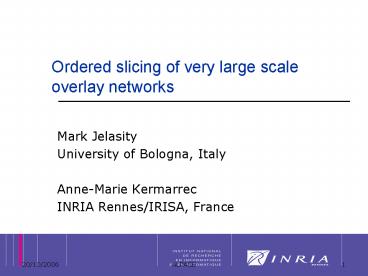Ordered slicing of very large scale overlay networks - PowerPoint PPT Presentation
1 / 28
Title:
Ordered slicing of very large scale overlay networks
Description:
Create and maintain partitions (slices) as subsets of the ... Newscast [Jelasity & van Steen, 2002] Peer selection: Select a peer at random from the view ... – PowerPoint PPT presentation
Number of Views:47
Avg rating:3.0/5.0
Title: Ordered slicing of very large scale overlay networks
1
Ordered slicing of very large scale overlay
networks
- Mark Jelasity
- University of Bologna, Italy
- Anne-Marie Kermarrec
- INRIA Rennes/IRISA, France
2
Motivation
- Potential of P2P technology
- Several applications running on the same
infrastructure - Need for network partitioning
- Decentralized
- Robust
- Handle dynamics
- Customizable
- Gossip-based approach to slice the network
3
Outline
- Introduction
- Background of gossip-based membership algorithms
- Ordered slicing
- Simulation results
- Conclusion
4
Objective
- Targeted applications
- Deskstop grids
- Testbed platforms (PlanetLab)
- Telco applications
- Resource assignment
- Objective
- Create and maintain partitions (slices) as
subsets of the network in a fully decentralized
manner - Ordered nature along a single attribute (memory,
bandwidth, computing power) - Our approach Use a gossip-based approach to
estimate to which partition a node belongs - Scalable
- Robust
- Based on local knowledge
5
Gossip-based protocols
- Unstructured peer to peer networks
- Highly resilient to failure and dynamics
- Gossip-based membership protocols
- Periodic exchange of information between nodes
- Basic functionality Peer sampling
- Provide a sample of peers given a metric
- Random sampling
- Applications
- Event dissemination
- Recovery protocols
- Aggregation
6
Gossip-based generic protocol
3
2
1 2 9 5
1
2 6 10 3
10
4
9
8
6
5
7
7
Gossip-based generic protocol
3
2
1 2 9 5 6 10 3
1
10
4
9
8
6
5
7
8
Gossip-based generic protocol
3
2
2 9 10
1
10
4
9
8
6
5
7
9
Design space
- Periodically each peer initiates communication
with another peer - Peer selection
- Selectpeer() return the IP_at_ of an alive peer
- View propagation
- How peers exchange their membership information
- View selection Select (c, buffer)
- c size of the resulting view
- Buffer information exchanged
10
Peer sampling algorithm
- Common framework for existing gossip-based
protocols - Lpbcast Eugster al, ACM TOCS 2003
- Cyclon Voulgaris al JNSM 2005
- Newscast Jelasity van Steen, 2002
- Peer selection Select a peer at random from the
view - View propagation Pushpull
- View selection Select the freshest entries
11
Random slices
3
2
1
10
4
9
8
6
5
7
12
Random slices
3 0.52
2 0.11
1 0.21
10 0.98
4 0.22
9 0.43
8 0.67
6 0.55
5 0.87
7 0.09
13
Random slices
3 0.52
2 0.11
1 0.21
10 0.98
4 0.22
9 0.43
8 0.67
6 0.55
5 0.87
7 0.09
14
Random slices
3 0.52
2 0.11
1 0.21
10 0.98
4 0.22
9 0.43
8 0.67
6 0.55
5 0.87
7 0.09
15
Ordered slices System model
- Problem
- Automatically assign a node to a slice
- Along an attribute metric
- System model
- Crash-only nodes
- Each node i has
- an attribute
- a random number
- a view of c entries (peer sampling)
- a time stamp
- Each node belongs to one slice
16
Ordered slicing algorithm basic operation
Node a
Node b
12
34
22
35
56
78
98
2
37
13
0.6
0.4
0.3
0.45
0.87
0.77
0.21
0.65
0.98
0.12
12
34
22
35
56
78
98
2
37
13
0.6
0.4
0.65
0.45
0.87
0.77
0.21
0.3
0.98
0.12
2
12
13
22
34
35
37
56
78
98
0.12
0.21
0.3
0.4
0.45
0.6
0.65
0.77
0.87
0.98
17
Ordered slicing algorithm
- Wait (t)
- plt- random element from view
- bufferlt-view U (my_at_, my_stamp, )
- Send buffer to p
- Receive buffer(p)
- viewlt-freshest c entries from buffer(p) U view
- ilt- peer such that
- Send ( ) to i
Receive buffer(q) from q bufferlt-view U (my_at_,
my_stamp, ) Send buffer to
q viewlt-freshest c entries from buffer(p) U view
Active thread at peer q
Passive thread at peer p
18
Ordered slicing algorithm maintenance
- New nodes discovered using the random peer
sampling - Random number ensures uniform spread
- Once the order stabilizes each node knows to
which slice it belongs - Example
- A peer with a number lt0.5 knows in the first 50
of the nodes according to the metric - Slice creation and maintenance
19
Disorder measure
20
Analogy with average
- Weight conserving property
- The swapping does not influence this value (0)
but always reduces the disorder value
21
Exponential decrease of the disorder
22
Swaps over time
23
Simulation set-up
- PeerSim simulator
- Configurations
- Network size 30,000 100,000 300,000 node
overlay - Views c20, 40 and 80
- Unreliable communication channels
- Churn
- Age bias peer selection based on age similarity
- Metric disorder
24
Churn
0.1
1
25
Age-based technique
Young nodes disordered Old nodes protected
26
Example
- Quick stabilization
- Relatively well-defined slices
- constant churn
- massive failure
- massive join
- Stabilizes as soon as churn stops
27
Conclusion future work
- Gossip-based solution to partition a dynamic
network according to a given metric - Resilient to churn
- Future work
- Slices maintenance
- Improve the peer selection
28
- Thank you !































